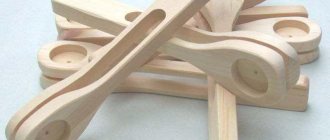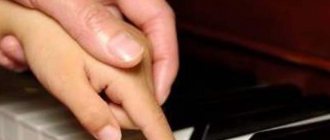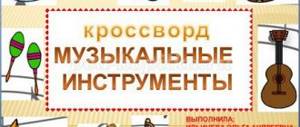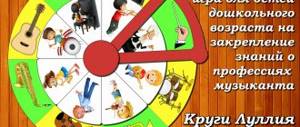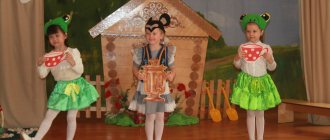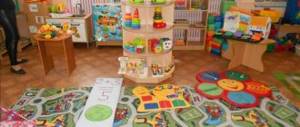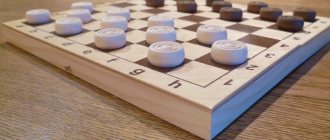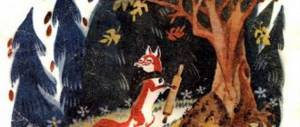Creation and operation of a music corner in kindergarten: role, meaning, goals and objectives
Musical education is included in the educational field “Artistic and Aesthetic” and is aimed at developing the emotional qualities of children. As an art form, music includes instrumental performance, singing and dance. Thus, musical classes contribute to the diversified development of children: auditory perception and oral speech skills are improved, mastering the sense of tact and rhythm will be useful in mathematical exercises in the future, and vocabulary is replenished.
Children aged 1.5–3 years learn to produce sound from simple instruments, become familiar with the concepts of “melody” and “rhythm”
The main forms of music education in kindergarten are standard and integrated classes in the music room. The music director is in charge of decorating the hall and conducting classes. The teacher accompanies the group and performs an organizational function: does rhythmic exercises together with the students,, if necessary, demonstrates any actions, joins in choral singing, distributes roles in musical games and dramatizations.
The teacher is present at children’s music classes and performs organizational functions
The role of the teacher in the musical education of children is to repeat with them the material they have learned and improve their existing skills. Musical-rhythmic games, listening to audio recordings and singing songs are included in DED classes (direct educational activities), on walks, and during leisure time in the afternoon. The subject-spatial environment of the group contains the necessary material base - a music corner is set up.
In the music corner, children consolidate the knowledge acquired in classes with a music director
At the center for musical development, the teacher conducts classes in a group form: children, together with the teacher, recall dance movements, learn songs, and continue to get acquainted with the work of famous composers. The atmosphere and content of the corner encourage students to independently study musical instruments, demonstrate creativity in dancing, singing, and composing melodies.
Children love to play and create in the music corner
The purpose of creating a music corner in kindergarten is to develop children’s creative abilities, develop the ability to respond emotionally to song and musical images, and cultivate a culture of listening. Children listen to instrumental or voice performances of melodies, try to convey in words or movements the feelings they experience. There is a lot of psychological research on the importance of music in the early development of children. Those who, from the first years of life, actively listened to music and revealed their talents in this area, have a high level of intelligence, including mathematical abilities.
Psychologists and teachers note the influence of active musical activity in early childhood on the development of thinking abilities
The educational and developmental tasks of the corner’s functioning are determined by the calendar and thematic planning of music classes: in the corner, children repeat new information, consolidate and develop skills. The teacher coordinates the work of the corner with the music director: what works to include for listening, what requires mandatory repetition. It is allowed to give children additional information in the music corner (“African Ris”), but do not conduct classes ahead of classes in the music room.
Table: tasks of organizing and operating a music corner
| Age group | Tasks | ||
| Educational | Developmental | Educational | |
| Younger preschoolers (1.5–4 years) | Repetition of what was learned in music classes:
|
|
|
| Middle group (4–5 years old) | Work on the topic of music lessons:
|
| |
| Senior group (5–6 years old) |
|
| |
| Preparatory group (6–7 years old) |
|
| |
In the music corner, children become active participants in instrumental activities
Equipping a music corner in a group (consultation for teachers) consultation on the topic
6
“Equipping a music corner in a group”
consultation for educators
The musical development of a child is determined not only by classes with a teacher, but also by the opportunity to play independently, experiment with musical toys, and freely engage in creative music-making. Independent creative activity of a child is possible provided that a special subject-development environment is created. For the development of children's independent musical activity, the music corner in the group (music zone) is very important. The development of children's creativity largely depends on the equipment and its attractiveness. Required: originality, simplicity, attractiveness, accessibility, as well as a sufficient range of tools, teaching aids, demonstration material, attributes, etc.
The music corner is a place where children learn about music and its beauty. A creatively designed music corner will not only help you plunge into the world of music and expand your understanding of it, but will also develop children’s imagination, activate the emotional sphere, thinking, and speech.
The teacher can choose the place for the music corner himself, taking into account the capabilities of the group and adhering to some rules. It is important that the music corner is located in a lighted place that is easily accessible to children; in addition, it should be isolated as much as possible, since, on the one hand, musical activities and games of children require concentrated auditory attention, and on the other hand, “sounding” activities should not interfere with other activities of preschoolers.
How to design a music corner?
Instructions
- When designing a music corner, you need to remember the age and individual capabilities of children. So, for children 3-5 years old, it is better to build the design on a plot basis, and for older children - on a didactic basis.
- The musical object environment must correspond to the eye, the actions of the hand, and the growth of the child.
- The music corner should have a closet, shelves for musical aids, a couple of tables, and chairs for educational games. The aids of the developmental environment are aesthetic, attractive, easy to use, and evoke a desire to act with them. There should be carpets and soft ottomans on the floor. This creates comfort and promotes concentration.
- It is better to put a DVD player in the corner, with which children can listen to music, various cartoons, as well as melodies that promote psychological relaxation and mental relaxation.
- Usually, stands are hung on the walls of the music corner. Lyrics of songs, poems, ditties, photographs of children's performances, composers, colorful posters, pictures of musical instruments are attached to them.
- In the music corner there should be toy musical instruments: a drum, a pipe, a miniature piano, a metallophone, and also musical toys.
It is useful to introduce a guitar, flute, violin, button accordion, and accordion into the music corner. By playing them, children develop their creativity, imagination, and musical memory. This arouses children's interest in music, develops musical and phonemic hearing and fine motor skills.
The music corner should be located very conveniently so that children can freely approach and take instruments and aids.
In order for children to constantly maintain interest in independent musical activities, it is necessary to update the manuals in the music area 1-2 times a month and introduce new equipment.
The music corner equipment is divided into two levels: for the teacher and for the children. On the top shelf are placed instruments that are used by children in doses (for example, a metallophone), and those with which children can only practice under the supervision of a teacher, in accordance with the sanitary and epidemiological standards of a preschool educational institution (pipes, harmonicas, etc.) . On the bottom shelf there are drums, spoons, triangles, maracas. It is necessary to pay special attention to the sound quality of musical instruments. They should be well tuned and make sounds familiar to children. Don’t forget that poor-quality sound cripples and pollutes a child’s hearing experience!
When selecting equipment for a music corner, you need to take into account the age of the children.
Music corners should contain:
- Material for creative role-playing games is
- Stuffed Toys;
- soft musical toys;
- tumbler dolls,
- figurative musical “singing” or “dancing” toys (dog, cat, cockerel, bunny, etc.)
- Figurative aids are
1) Portraits of composers (whose works children sing or listen to)
2) Musical and didactic games: board-printed musical games for the development of pitch hearing, sense of rhythm, timbre hearing, and for consolidating program material
- "Birds and Chicks"
- "The doll walks and runs"
- “Guess what I’m playing?”
- "Repeat the sounds"
- "Where are my kids?"
- "What are the children doing?",
- “Compose a song according to a rhythmic pattern”,
- "Guess who's singing"
- "Be quiet - beat the tambourine louder"
- "Name the song from the picture"
- "Wonderful bag."
Musical and didactic games should be varied in content and colorfully designed, then they will attract the attention of children, arouse the desire to play, sing and listen to music.
3) Illustrations
- “Loto” type manuals: cards with pictures drawn or pasted on them
(eg, image of various musical instruments: drum, bell, pipe, metallophone, etc.)
- all kinds of pictures:
- little books “We Sing”,
- musical pictures for songs, which can be made on a cube and in the form of a large album or individual colorful illustrations,
- illustrations on the theme “Seasons”,
- illustrations from the “Musical ABC Book”,
- illustrations of musical instruments,
- notes,
- pictures of animals singing, dancing or playing musical instruments,
- albums “We Draw a Song” or “We Draw and Sing” with children’s drawings, in which they reflect their emotions and feelings about the pieces of music they listened to and their favorite songs,
- albums for viewing “Symphony Orchestra”, “Folk Instruments”, “Dances of the Peoples of the World”,
- graphic aid “Emotions” (cards depicting faces with different emotional moods) to determine the nature of the melody when listening to works.
- Unvoiced children's musical toys and instruments, or fake musical instruments - toys (what are they?) - these are
- unvoiced planar musical instruments made of thick cardboard or thin plywood, which are designed to create play situations in which children, imagining, imagine themselves as musicians playing musical instruments (for example, models of domra, piano, accordion, balalaika, etc. .).
- an album of songs with illustrations from the group’s repertoire, and each picture should reflect the content of a specific song
- Voiced musical instruments and toys, which are divided into 4 types depending on their sound:
1) toys-instruments with sound of indefinite height (for example, tambourines, rattles, drums, maracas, small and large bells, bells, etc.)
— To develop pitch hearing, you can use bells that sound different in height, and children will learn which bell “sings” higher and which lower, or a metallophone placed at an angle can become a musical ladder.
— To develop rhythmic hearing, it is better to use all instruments of the percussion group or any instrument that has the sound of only one specific pitch. For example, children play “musical echo”: one child comes up with his own rhythm, and the other repeats it exactly.
— For the development of timbre hearing, it is very useful to compare the sound not only of “representatives” of different groups - strings, wind or percussion, but also to invite children to note homogeneous instruments that are similar in timbre and sound character, for example, bells and tambourines, metallophones and triangles, etc. d.
(musical hammer, barrel organs, guitars, rattles, musical tops, etc.) children look at them, try to extract individual sounds or a fixed melody from them.
2) toys-instruments that produce only one sound (for example, whistles, pipes, horns, flutes, squeakers, whistles, saxaphones, etc.)
3) toys-instruments with a fixed melody (for example, organs, barrel organs, music boxes, etc.)
4) toy instruments with diatonic and chromatic scales for creative music playing (for example, metallophone, xylophone, accordion, children's piano, organola, etc.)
- Homemade noise and percussion musical instruments from natural materials (according to the concept of Carl Orff):
1) all kinds of rustling paper (various papers: cellophane, parchment, newspaper, etc.);
2) rustling instruments:
a) shells, acorns, beans, poured into all kinds of boxes like “Kinder Surprises”;
b) metal cans of different sizes, which can form a family of drums;
c) all kinds of bracelets, with buttons and bells strung on a thread,
shells that are worn on the wrists, slingshots with thread and sparkling water caps strung on it, etc.
- Technical means
It is advisable for each group to have a tape recorder and arrange a library of discs with a musical repertoire (a set of cassettes or discs with recordings of children's songs, folk and classical music, voices of birds and animals, noises of natural phenomena and water, Russian folk tales and fairy tales of the world, folk dance melodies, musical fairy tales). You can use headphones so that one child does not disturb others while listening to music. The music library helps to further develop children's musical ear and acquire musical knowledge, ensuring the comprehensive development of each child's personality. In this case, the teacher will be able to satisfy the children’s desire to listen to music, dance, sing, or just play.
- Attributes for outdoor musical games and children's dance creativity: Caps - masks, Caps - ears, horses, musical handlebars ("Cat and Kittens", "Hen and Cockerel", "Round Dance in the Forest", "Raven", "Cat and Mice" , "Hares and the Bear"). In the dressing corner there are kerchiefs of nesting dolls, aprons, etc. And also multi-colored flags, plumes, handkerchiefs, bright ribbons with rings, rattles, balls, dense inflatable balls with cereals, multi-colored cubes, autumn leaves, snowflakes, bells, depending on the season.
- Theaters
Types of theaters:
- theater of pictures (Flanelegraph)
- Finger Theater
- Puppet show
The role of the teacher is to encourage children to apply the skills learned in music classes in the daily life of the kindergarten.
Independent musical activity in a group is one of the indicators of the level of development of children; it gives an idea of the amount of skills, abilities, and knowledge that children have received as a result of the work carried out with them. There is a transfer of methods of action mastered in music classes to completely new conditions and situations; the child acts on his own initiative, in accordance with his interests, desires, and needs.
Decorating a music corner in a kindergarten
The music corner in the group room is designed taking into account the age and individual characteristics of children. The material base is replenished with each year of study in kindergarten. Thus, musical toys are selected for younger preschoolers, and older children learn to play real instruments.
For the little ones, the instrumental base of the music corner consists of toys: whistles, tumblers, hammers, rattles
Some of the items for classes in the music corner are made with our own hands. It is recommended to involve children and their parents in productive creativity: the motivation to play music with those instruments that the pupils have made on their own (maracas, drums, rattles, etc.) increases. For example, Kinder Surprise containers are filled with cereal and attached to sticks to create rattles. Maracas are made using the same method, but you need larger plastic containers (from drinking yogurt). A kind of tambourine is made from bottle caps strung on thick wire. The drum can be easily made from a wide jar with a plastic lid (mayonnaise), and a tom-tom from a tall tube of Pringles chips.
Waste material and active imagination are what is needed to make unusual musical instruments
In the music corner for all ages there are fake musical instruments: drawn on cardboard, made of papier-mâché. It is impossible to extract sound from them, but they convey the appearance of complex instruments (piano, accordion, harp, for example) and can be used in gaming activities.
Prop instruments perform an educational task (form ideas about real instruments) and serve as attributes for games
The furniture for the music corner can be wooden or plastic; you can use soft modules as seating. Teaching materials and tools are stored on shelves and in drawers; some of the tools can be placed on the wall.
Some of the tools can be beautifully placed on the wall of the corner
The music corner for children 1.5–4 years old is designed on a plot basis, for pupils 5–7 years old - on a didactic basis. Let's give an example. In the younger group there is a corner “Papa Carlo’s Theater”: on the shelves there are musical toys and instruments made from waste material, next to it there is a table with a screen, and dolls-characters from the fairy tale “Pinocchio, or the Golden Key” are waiting for the children. In the senior group, a developmental corner “Musical Carousel” has been organized: a shelf with didactic and board-printed games has been allocated, the information stand is regularly updated with song lyrics, portraits of composers, photographs of various types of musical art (opera, ballet, folk genres).
For younger preschoolers, the design of the music corner is based on a plot, in this case - based on fairy tales
Requirements for the design of a music corner
- Optimally convenient location. The musical corner is organized in the area of creative activity: next to the centers of mummery and theatrical activities. Independent dramatization games, for example, are often carried out with children using materials from each of the named corners at the same time: in the mumming corner, children choose costumes and assign roles; in the theatrical corner, they act out a skit to the accompaniment of instruments from the music corner.
- Compliance of equipment and materials with the age of the students. The instruments that they learned to play during music lessons are freely available to children. Visual materials for younger pupils - singing toys, simple instruments (organs, pipes, whistles, rattles), thematic albums with pictures; for older people - more complex instruments (balalaikas, xylophone), illustrated encyclopedias, mini-exhibitions.
- Aesthetics. The music corner is visually attractive for students. They can participate in decoration: draw posters together with the teacher, decorate a stand and wall newspapers, create drawings and crafts on the theme of music.
- Safety. For all areas of the subject-development environment, furniture from environmentally friendly materials is selected. The exhibition of tools is organized on a table (hanging shelves are not recommended). Children's balalaikas, guitars, and harps must have plastic strings (a broken metal string is dangerous). The speaker system or tape recorder for playing audio recordings, as well as power sources (electrical socket, tee) are kept out of the reach of children.
- Availability of an audio player (tape recorder, speaker system) and a collection of audio recordings: collections of children's songs, folk and classical music, musical audio tales.
Video: music corner in a nursery group
Video: music corner in the younger group
Video: music corner in the senior group
Video: music corner in a mixed age group
Music Corner Passport
The passport of the subject development zone is an information document that provides characteristics of the activity center, a description of the material base and a list of games and exercises for children. The music corner’s passport is drawn up by the group teacher and approved by the music director and the kindergarten administration. This document is stored in the teacher’s folder and is provided for review by colleagues, young professionals, and parents of students.
Music Corner Passport Template:
- The name of the corner, what age category of children it is intended for.
- Tasks of the corner (briefly).
- Furniture items, quantity.
- Electrical appliances, if any (speaker system/player/cassette recorder, TV, projector).
- List of visual teaching aids (posters, illustrations, thematic albums with pictures, encyclopedias).
- List of musical instruments, quantity.
- Didactic and board games.
- Sets for dramatization games and role-playing games.
- Card index of musical-rhythmic exercises and games.
Fragment of the passport of the music corner of the first and second junior groups (list of material resources)
- tumbler dolls;
- figurative musical “singing” or “dancing” toys (cockerel, cat, bunny, etc.);
- toys-instruments with a fixed sound - organs, organs;
- toys-instruments with a sound of indefinite pitch: rattles, bells, tambourine, drum;
- a set of unvoiced figurative instruments (accordions, pipes, balalaikas, etc.);
- attributes for musical outdoor games: flags, plumes, scarves, bright ribbons with rings, rattles, autumn leaves, snowflakes, etc. for children's dance creativity (by season);
- table screen with glove toys;
- tape recorder and a set of software audio recordings;
- singing and moving toys;
- musical pictures for songs.
What to call a music corner
There are many options for naming centers of creative activity. The very atmosphere of art and the aesthetics of the design of the corner activates the imagination, so it is recommended to choose a name together with the students. You can give the task to come up with a name for the music corner and an emblem together with your parents. Unusual names arouse increased interest in studying the materials of the development center; traditional naming shows that the corner is a platform for the educational process, and not entertainment.
- Classic names: “Musical corner/island/kaleidoscope/kiosk”, “Merry notes”.
The classic name is clear to children and encourages them to take their studies seriously.
- Creative titles: “Treble clef invites/Treble clef school”, “Musical town”, “Doremishka”, “Domisolka”, “Musical palette/country”, “Note city”, “Leisya, song!”, “Play, accordion! ", "Rainbow of Melodies", "From Note to Note", "Melodies of Childhood", "Territory of Music", "Musical Living Room".
Funny names attract and evoke positive emotions in children
Means for decorating a music corner
One of the main requirements for the design of a music area in a group’s premises is aesthetics. Children feel cozy and comfortable in the corner. Bright colors in the design create a good mood. Examples of children's productive creativity can decorate the corner: drawings, crafts, layouts. Parents are involved in the design of the development zone: they draw posters and wall newspapers together with their children.
Plates: photo gallery
The cheerful characters on the sign encourage a positive attitude towards activities in the corner. The content of the sign reflects the direction of activity in the corner.
Favorite cartoon characters attract children
Development centers are designated accordingly. Each corner should have a sign or emblem with its name. It is recommended to place pictures and symbols on the sign indicating the direction of educational activities in the corner. The presence of the children’s favorite characters on the sign brings them joy. Emblems and signs are kept in the same style in the group room as a whole or among creative corners.
Stand: design options in the photo
The music stand contains song lyrics and rules of rhythm games.
The stand displays photographs from past musical events and holidays.
Sketch of a music corner stand
Important information is placed on the staff The bright design attracts children to study the materials attached to the stand
The music corner stand contains information for parents: lesson topics, song lyrics
The music corner stand contains text and graphic materials. It is convenient to place drawings, printouts, diagrams in plastic pockets; the use of pushpins in kindergarten is undesirable. When creating a stand with your own hands (a sheet of whatman paper or cardboard), use musical symbols and bright colors for decoration. What is on display at the stand:
- lyrics for learning;
- schemes of articulatory and rhythmic exercises;
- topics for future leisure activities, master classes;
- drawings by students on the theme of music;
- photos from musical events in kindergarten.
Decorative stickers for photos
Bright stickers will decorate a plain wall. Cats are children's favorite animals.
Pictures for the wall are inexpensive, but look impressive
Stickers in the music corner contain special symbols
Stickers on the wall can be used as a background for games (“In the orchestra”, “Big concert”, “Musical theater”)
In modern kindergartens, the walls of the hall, concert hall, and group rooms are decorated with drawings and graffiti. To decorate a corner, we recommend using a much simpler and more economical option - decorative stickers. They are sold in craft stores (Leonardo Hobby Hypermarket) and are widely represented on Aliexpress, Pandao, Taobao. The advantages of these stickers are their original design and ease of use. Decorative stickers are mobile: they are easily removed and do not leave marks on the surface, do not lose their adhesiveness, and the components of the composition can be swapped. Decorative stickers for the music corner are selected with images of notes, treble and bass clefs, and musical instruments. Such images are used as educational visual material, as a background for the games “Orchestra”, “Concert”, “Musical Theatre”.
Illustrative materials: photo gallery
Posters and pictures are used to review what has been learned in music classes.
Portraits of composers decorate the music corner as new names in the world are explored in music classes
The visual material of the corner is drawn musical instruments and a musical staff
A picture poster decorates the music corner
The poster design uses poems about musical instruments
The following illustrative materials are used to decorate the music corner:
- posters: “Wind instruments”, “Percussion instruments”, “String and keyboard instruments”, “Folk instruments”, “Symphony orchestra”, “Dances of the peoples of the world”;
- portraits of composers: Prokofiev, Tchaikovsky, Rachmaninov, Mussorgsky, Glinka, Beethoven, Bach, Grieg;
- drawn musical instruments: balalaikas, guitars, accordions, violins;
- Hand-drawn posters: pictures on the theme of music, songs and dances, with inscriptions and lines of poetry.
Dolls: options in the photo
The doll shows how you can practice playing the piano
Dolls invite you to get acquainted with musical instruments
Dolls in costumes are waiting for the beginning of a musical fairy tale
In the design of the music corner, dolls are used as an aesthetic element: they can be part of the composition. Children can use them for dramatizations. But, if you make them animated characters in the corner, this will diversify activities with children of primary and secondary groups. The doll can show children a new instrument and demonstrate how it is played. With the help of a doll, a problematic situation is created: “Katya forgot the words of the song you learned in class, can we help Katya?”, “Lala doesn’t know how to dance, can you show me?”
Theatrical area: photo
The atmosphere of the music corner encourages creativity
The music corner rack has a screen in the middle for dramatization games
Musical and theatrical corners are sometimes combined into one developmental area in kindergarten
One of the forms of work in the music corner is to conduct dramatization games with musical and song accompaniment. To create a small musical performance, a place is allocated in the corner for performances with hand puppets, bibabo, and simple puppets. As a rule, this is a table with a screen. If desired, children supplement the space of the theatrical area with toys, building a kind of scenery: they put up tree toys, buildings made of blocks and construction sets, etc. The atmosphere of the music corner, contact with the world of music, the study of musical fairy tales - all this encourages children to create, and the task educator - to create conditions for the manifestation of young talents.
Table: equipment for the music corner
| First and second junior groups |
|
| Middle group |
|
| Senior group |
|
| Preparatory group |
|
Approximate design sketch for a music corner
When thinking about organizing a music corner, follow the principle of compactness. The area for didactic games and performances can be combined - there will be a table and chairs according to age. There are shelves with a “window” for theatrical activities.
The music corner for younger preschoolers contains freely available toys and instruments that are understandable and safe for children.
Toys and tools are located on low shelves and a table; there is a convenient area for dramatization games
In the senior and preparatory groups, a stand is required; children learn to work using mnemonic tables and diagrams. Illustrative material is placed there or on a shelf allocated for temporary exhibitions (by types of instruments, works of composers). Children aged 5–7 years old love to play board games; a work table is provided for this activity (and for completing didactic tasks). Older preschoolers are offered folding paper or cardboard screens for dramatization; they can draw them together with the teacher in a creative workshop.
In older groups, it is mandatory to have an information stand, a place for didactic and board games, and a shelf/table for temporary exhibitions
Consultation for teachers “Music Corner”
Music corners should contain:
- Neo-sounding musical instruments;
- O sonorous musical instruments;
- Musical toys;
- Homemade musical instruments;
- Musical and didactic games;
- Technical means (audio and video recordings).
The corner is updated 1-2 times a quarter!
- introduce new musical and didactic games,
- new equipment and homemade musical instruments.
“Musical corner of the 21st century” or “Modern trends”
The group must have audio and video equipment, CD and DVD players, headphones (for older preschool age), so that one child does not disturb others while listening to music.
A selection of children's contemporary songs and classical music in accordance with the age category of children.
High-quality sound of musical instruments (including electronic ones), i.e. well-tuned and producing sounds familiar to children (so as not to pollute the child’s auditory experience).
Answer the questions:
- What is the main purpose of the music corner:
- teach musical literacy
- develop creativity
- cultivate aesthetic taste
- strengthen the physical and mental development of the child?
- What levels is the music corner divided into and why?
- How many times are manuals and materials updated per year?
- What do modern trends require?
Musical corners in groups.
List of materials for children from 2.5 to 4 years old
(1st and 2nd junior groups):
- tumbler dolls;
- figurative musical “singing” or “dancing” toys (cockerel, cat, bunny, etc.);
- toys-instruments with a fixed sound - organs, organs;
- toys-instruments with a sound of indefinite pitch: rattles, bells, tambourine, drum;
- a set of unvoiced figurative instruments (accordions, pipes, balalaikas, etc.);
- attributes for musical outdoor games;
- flags, plumes, scarves, bright ribbons with rings, rattles, autumn leaves, snowflakes, etc. for children's dance creativity (by season);
- table screen with glove toys;
- tape recorder and a set of software audio recordings;
- singing and moving toys;
- musical pictures for songs, which can be made on a cube and in the form of a large album or individual colorful illustrations.
List of materials for children 4-5 years old
(middle group of kindergarten):
In the music area for independent activities of children 4-5 years old, it is advisable to have:
- glockenspiel;
- noise instruments for children's orchestra;
- little books “We Sing” (they contain bright illustrations of familiar songs);
- flannelograph or magnetic board;
- musical and didactic games: “Three Bears”, “Recognize and Name”, “In the Forest”, “Our Orchestra”, “Seven-Flower Flower”, “Guess the Bell”, etc.;
- attributes for outdoor musical games: “Cat and Kittens”, “Hen and Cockerel”. “Hares and the Bear”, “Pilots”, etc.
- musical ladders (three-step and five-step, on which there are small and large birds or a small and large nesting doll;
- ribbons, colored scarves, bright plumes, etc. (attributes for dance improvisations, but for the season;
- table screen and a set of toys;
- musical toys (sounding and noise) for creative music making:
- tape recorder and a set of software audio recordings.
List of materials for children 5-6 years old
(senior kindergarten group):
In addition to the middle group materials, the following is used:
- rattles, tambourines, drums, triangles, etc.
- musical toys-instruments with diatonic and chromatic sound (metallophone, piano, button accordion, accordion, flute);
- illustrations on the theme “Seasons”;
- homemade musical toys (noise orchestra);
- portraits of composers;
- illustrations from the “Musical ABC Book”;
- musical and didactic games: “Bee”. “Musical Lotto”, “Recognize and Name”, “Steps”, “Repeat the Sounds”, “The Three Little Pigs”, “Magic Top”, “Musical Train”, “Guess What Sounds”, etc.
- attributes for outdoor games (“Round Dance in the Forest”, “Raven”, “Cat and Mice”, etc.);
- children's drawings for songs and familiar pieces of music;
- screens: tabletop and screen according to children’s height;
- three-, five- and seven-step musical stairs - voiced;
- attributes for children's dance creativity: elements of costumes for familiar folk dances;
- multi-colored feathers, multi-colored gloves for musical improvisations behind a screen and other attributes;
- attributes for dance improvisations according to the season - leaves, snowflakes, flowers, etc.):
- a tape recorder and a set of software audio recordings or disks.
List of materials for children 6-7 years old
(preparatory group of kindergarten):
- musical instruments (maracas, tambourines, harp, children's piano, metallophone, bells, triangles, flutes, drums, etc.);
- portraits of composers;
- illustrations on the theme “Seasons”;
- pictures for the manual “Musical ABC Book”;
- albums: “We draw a song” or “We draw and sing” with children’s drawings, in which they reflect their emotions and feelings about the pieces of music they listened to and their favorite songs;
- graphic aid “Emotions” (cards depicting faces with different emotional moods) to determine the nature of the melody when listening to works;
- albums for viewing: “Symphony Orchestra”, “Folk Instruments”, “Dances of the Peoples of the World”, etc.;
- musical stairs (three-, five- and seven-step - voiced);
- a set of homemade instruments for a noise orchestra;
- musical and didactic games: “Three Little Pigs”, “Three Flowers”, “Musical Umbrella”, “Ri”, “Rhythmic Cubes”, “Name the Composer”, “Funny Record”, “Musical Chicks”, etc.;
- attributes for outdoor games (for example, “Hello, autumn”, “Cosmonauts”, etc.);
- attributes for children's dance creativity, costume elements for familiar folk dances (kerchiefs, wreaths, hats) and attributes for dance improvisations according to the season (leaves, snowflakes, flowers, etc.); multi-colored gloves, plumes, gauze or scarves, multi-colored ribbons, multi-colored feathers for music and dance improvisations; tape recorder and a set of software audio recordings or disks »
CONSULTATION FOR TEACHERS
TOPIC: ROLE OF THE TEACHER IN MUSICAL CLASSES AND HOLIDAYS
Among the many recent problems related to preschool education, the problem of interaction between educators and specialists stands out. And the problem of pedagogical interaction between the teacher and the music director is one of the most important: the success of the process of not only musical, but also the general aesthetic development of preschool children depends on its solution.
We, music directors, would like to see the interest of teachers in the process of music lessons. When a child sees that the teacher completes all the tasks with interest, he becomes involved in the process with even greater inspiration. After all, the teacher is an absolute authority for him, and no matter what happens in class, the child will constantly focus on the teacher.
How does a teacher’s interest in a music lesson show? First of all, the teacher needs to understand that in a music lesson he is as much a participant as the children, and not an overseer. Imagine that you are a child, everything is interesting to you and you and your children cheerfully sing songs, dance fervently, listen to music thoughtfully... And you do this not as a duty, but with your soul, but do not forget that there is a pedagogical process that needs to be controlled.
And now let’s move on from aesthetics to organizational issues.
SO:
1. During a music lesson, children should be smartly dressed,
wear comfortable shoes, girls must wear skirts.
2. starting from the middle group of children, it is necessary to build, alternating
boy and girl.
3.You should arrive to class 2-3 minutes before the start so that
line up and get the children ready for the activity.
4. The teacher brings with him a notebook with a hard cover on
spirals and pen to write down words of songs, games, movements
dances, recommendations, etc.
5. During class, it is advisable not to leave the hall, so as not to
skip some material.
6.Do exercises with the children. Movements of dances, games,
sing songs, etc.
7.Monitor the children’s movements correctly
8.Before class, it is necessary to maintain musical silence: do not
turn on the tape recorder, since children have hearing loss
perception and concentration
9. In free activity, consolidate the material received in class.
Nitophone, audio materials.
Work in the music corner of a kindergarten
The activities of students in the music corner are carried out in joint classes with the teacher - individual or in a subgroup, and in independent form. The teacher works with the children in the corner as directed by the music director: with whom to work on dance skills, with whom to repeat the song, when to consolidate the learned material.
But more often, children independently become active in playing music and dancing. The teacher thinks through and designs the music corner so that it is in demand by the children, and plays a minor role in organizing independent games. Surprise moments help stimulate interest in activities in the corner (“A package of dance caps was delivered to our corner!”, “Today is Sveta’s doll’s name day, let’s arrange a small concert in honor of the holiday!”, “Yesterday I learned the rules of the musical lotto and I want to tell you about them!”), preliminary study of visual materials and listening to audio recordings.
Activities in the music corner
- Outdoor games. Conducted with mandatory musical accompaniment. The leader in outdoor games with primary and secondary preschoolers is the teacher; older children choose the leader themselves. An example of a game for kids: “Carousel”. The teacher puts on a belt with wide ribbons hanging, stands in a circle of children, and the kids take hold of the ribbons. Music sounds, children move in one direction to the music, twirl ribbons around the teacher, and change direction on command. An outdoor game for older preschoolers - “Pilots”: the leader gives a command, the children carry out (“Pilots, start the engine!” - make rotational movements with their arms, “Let’s take off!” - spread their arms to the side, begin to move, “Let’s land!” - slow down , stop), each landing involves the inclusion of excerpts of national songs on the player, children must move to the beat.
- Dance improvisations. Children perform dance moves to the music. Seasonal dance improvisations are carried out with appropriate attributes: in autumn - with artificial branches, in winter - with paper snowflakes, in spring and summer - with flowers and wreaths. For improvisations with elements of national dances, tambourines (tarantella), castanets (Mediterranean dances), handkerchiefs and wooden spoons (Russian folk dances), maracas (Latin American motifs) are used.
- Musical improvisations. Usually children include them in role-playing games: “Orchestra”, “Festive Concert”. For musical improvisations of older preschoolers, a leader is selected - a conductor; the roles of musicians are distributed among the other participants in the game - violinist, drummer, flutist, accordionist, etc. The “conductor” gives the command when to join the game for each of the “musicians” and when to stop performing.
- Didactic games. With younger pupils, the teacher conducts games to recognize the sound of instruments (plays an instrument behind a screen or turns on an audio recording, and the children name the instrument), to determine the nature of the music (children show pictures of an emotional state or a symbol for the sounding melody: sad, calm, cheerful), to reproduce a sound pattern (children are asked to show with their voice the depicted pattern: a line with bends - the melody is smooth, the line gradually tends downwards - a transition from a loud sound to a quiet sound, etc.). For older children, games are suitable for identifying the strong beat in a musical passage (they show the strong place on the card), for guessing familiar musical compositions (the game “Flower of Seven Flowers”: on each petal there is an illustration of a work whose name you need to remember) and composers (the game “Records”: having guessed the name of the composer whose work is heard, children stick a card with a portrait of the author onto the record).
- Dramatization games. The dramatization of fairy tale plots familiar to children involves the emotional disclosure of characters in accordance with the music playing. Musical games-dramatization in kindergarten: “The Fox and the Hare”, “Teremok”, “Zayushkina’s Hut”, “Turnip”, “Kolobok”, “Gray Neck”.
How to set up music corners for different age groups
Svidinskaya T.V. How to equip musical corners in different age groups // Sovushka. 2020. N2(12). URL: https://kssovushka.ru/zhurnal/12/ (date of access: 10.10.2020).
Order No. 89679
When children are free, they show individual inclinations: they draw, sculpt, sing, play music with the help of children's musical instruments, that is, they act independently. In order for this activity to develop as successfully as possible, it is necessary to create appropriate conditions: allocate a place for classes, arrange a music corner and equip it with aids.
In the corner there should be a shelf for musical aids and educational board games. The main content of the corner consists of various musical aids. These are musical toys and children's musical instruments, which are selected taking into account the age of the children and the sequence of familiarization with a particular instrument during musical lessons. Musical toys are most often used in story-based and educational games. They are mainly used by very young children (rattles, pipes, bells, etc.). Of course, they are greatly simplified and do not completely reproduce the sound of real ones, although sometimes they bear their names and are similar in appearance. These are a variety of teaching aids and games, some of which are homemade. There are also attributes and costume elements used by children in musical games, dramatizations, and dances.
To develop pitch hearing, you can use bells that sound different in pitch, and children will learn which bell “sings” higher and which lower.
To develop rhythmic hearing, it is better to use all instruments of the percussion group or any instrument that has the sound of only one specific pitch. For example, children play “musical echo”: one child comes up with his own rhythm, and the other repeats it exactly.
For the development of timbre hearing, it is very useful to compare the sound of a string, wind or percussion group, but also to invite children to note homogeneous instruments that are similar in timbre and sound character, for example, bells and tambourines, metallophones and triangles.
Recommendations for equipping music corners.
In kindergarten, in order to introduce a child to music and develop his musical abilities, various musical instruments, toys, paintings and visual aids are used. The success of music education largely depends not only on sufficiently equipping classes with didactic aids and other materials, but also on their correct use outside of class, taking into account the age of the children, their interest and the specific capabilities of the kindergarten.
Children of the younger group are given percussion instruments: tambourine, drum, rattles, bells and noise instruments - rattles, rustles.
From the middle - you can add wooden sticks, wooden spoons, a metallophone (in the second half of the year) as well as various boxes with fillings.
The older ones are rumba, triangle metallophone, as well as noise instruments.
Preparatory - maracas, rattle, castanets, xylophone, zither and noise instruments that can be used in role-playing games.
Throughout the year, toys and aids are changed, put away and brought back again in order to maintain interest in them and the desire to act with them.
It is advisable for each group to have a tape recorder and a small set of cassettes or disks with recordings of children's songs, folk dance melodies, and musical fairy tales. In this case, the teacher will be able to satisfy the children’s desire to listen to music, dance, sing or just play.
Literature:
- Zatsepina M.B. Musical education in kindergarten. M., 2008.
- Arsenevskaya O.N. System of musical and recreational work in kindergarten. Volgograd, 2011.
- Arsenevskaya O.N. Musical lessons. 1st junior group. Volgograd, 2012.
- Butenko E.V. Musical games and entertainment. 2-3 years. M., 2011.
- Sorokina N.F. Puppet theater for the little ones.
- Radynova O.P. Musical development of children. M., 1997.
- Yurchuk E.N. Emotional development of preschool children.
- Toys and aids for kindergarten / compiled by L.F. Ostrovskaya; edited by V.M. Izgarsheva. M.: Education, 1982. 175 p.
